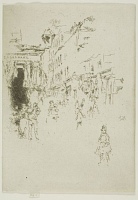Etchings Institutions search term: dowdeswell
Cutler Street, Houndsditch | ||
| Number: | 361 | |
| Date: | 1887 | |
| Medium: | etching | |
| Size: | 178 x 128 mm | |
| Signed: | butterfly at right | |
| Inscribed: | no | |
| Set/Publication: | no | |
| No. of States: | 2 | |
| Known impressions: | 8 | |
| Catalogues: | K.292; M.287; W.234 | |
| Impressions taken from this plate (8) | ||

The copper plate was acquired from Hughes & Kimber Ltd, and bears their oval stamp: 'HUGHES & KIMBER (LIMITED) / MANUFACTURERS / LONDON E.C.' They were Whistler's preferred suppliers at this time, and supplied the plates for most of his known Houndsditch subjects. Out of all Whistler's surviving plates, 168 were obtained from that firm, and a high proportion, over sixty, date from 1887.
This plate, with Melon Shop, Houndsditch
[355] and After the Sale, Clothes Exchange, Houndsditch
[357] is on the smallest-sized Hughes & Kimber plate, 178 x 128 mm, which was one of Whistler's most frequently used formats; next in size is St James's Place, Houndsditch
[255] at 82 x 178mm (possibly a plate of 128 x 178mm cut in half); then there are three larger plates, Clothes-Exchange, Houndsditch. No. 2
[359] and Clothes-Exchange, Houndsditch. No. 2
[359] at 229 x 153mm, and finally the largest one, Clothes-Exchange, Houndsditch. No. 1
[358] at 162 x 242mm.
Whistler etched a lot of plates of the same size as Cutler Street, Houndsditch, mostly from the same maker, including other London scenes (i.e. Nut Shop, St James's Place, Houndsditch
[356],
Melon Shop, Houndsditch
[355]), Queen Victoria's Jubilee subjects (i.e.Wild West: The Orator
[294]), studies of models (i.e.Cameo, No. 1 (Mother and Child)
[459]), and a Belgian view (The Barrow - Quartier des Marolles, Brussels
[346]), most of which date from 1887. Also in the same size are views done on the Whistler's honeymoon in the Loire valley (i.e. Little Market Place, Tours
[389]) and in subsequent years in Amsterdam and Paris (i.e. Little Drawbridge, Amsterdam
[448],
Greengrocer's Shop, Paris
[471]).
The plate was in Whistler's studio at his death, and was bequeathed to Rosalind Birnie Philip (1873-1958) who gave it to the University of Glasgow in 1935. It was cancelled posthumously with a diagonal line across the lower left corner.
